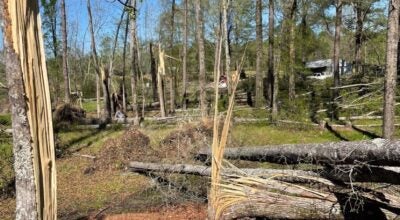Six years of action in Black Belt region
Published 12:07 am Tuesday, August 24, 2010

Gov. Bob Riley, right, thanks volunteers and committee members for their dedication to the Black Belt Action Commission. Co-chair members Sheldon Day, left, state Sen. Hank Sanders and Margaret Bentley celebrate the sixth anniversary of the commission at an event at Alabama State University Monday. --Laura Fenton photo
MONTGOMERY — Six years ago, people were skeptical of the Black Belt Action Commission’s success.
Margaret Bentley, co-chair of the commission, listened to comments from people unconvinced the commission would successfully start or ever make an impact in the region.
But it did.
Members of the Black Belt Action Commission and Gov. Riley celebrated the sixth year of the commission, a volunteer coalition dedicated to improving the Black Belt region in categories from health care to tourism and education.
“Now when I talk about the Black Belt Commission, I don’t hear that,” Bentley said. “People believe that there is too much wonderful work being done. There’s a lot more to do, but I know there’s a brighter future. I’m positive of that.”
The commission has created dozens of initiatives such as the Black Belt Nature and Heritage Trail guide, which features more than 50 destination such as Kenan’s Mill, Paul M. Grist State Park and Marion Fish Hatchery; the 2-1-1 Connect program, a one-call service that offers access to programs that provide employment support, help for the elderly or disabled and volunteer opportunities and Black Belt Treasures in Camden which showcases art of the region.
“We call it an action commission because we have studied it long enough,” said Gov. Bob Riley. “We knew what needed to be done over there. The biggest thing we did then was to go out and find a group of volunteers to say we’re going to make it better, and we’re going to make it better in spite of everyone’s predictions that we can’t.”
Riley encourages the next governor to continue the commission because he believes there is still a lot to be done to improve the region.
“There will be a lot more to be done six years from now, but that’s why I hope the next governor really does take this and say we’re going to continue it and we’re going to continue to make it a priority,” Riley said.
One of the newest initiatives of the agriculture committee is a Black Belt Fruit and Vegetable Marketing Center, which will be located in Dallas County at the old site of the Southwest Alabama Farmer’s Co-Op on Highway 80 West.
“It will be a facility for farmers, small farmers in the Black Belt, to bring their fruits and vegetables, things like watermelons, peas, okra and greens, to market to buyers in Alabama and beyond Alabama,” said John Zippert, chair of the agriculture committee.
The center also plans to partner with Tuskegee University, Auburn University and Alabama A&M University to add a research and education component to the operation.
Construction of the facility should begin later this year.
“I really think it will be operational by the end of next year and certainly for the 2012 spring vegetables,” Zippert said.
Committees search out projects to enhance the community and then find the necessary resources to complete it. The commission does not have an annual budget or maximum number of projects to complete each year.
“People who have been involved for these six years have been dedicated to transforming the Black Belt, not trying to get resources to take other places,” said Senator Hank Sanders, co-chair of the commission. “The goal of the Black Belt Action Commission is to transform the Black Belt. You can’t transform it by just working in education or working in economic development, working in tourism or working in family. You have to work in all these areas to be able to transform it. All of these come together to move us one step closer to transformation.”
The Black Belt Action Commission is comprised of 13 departments: agriculture, communication, community development, culture and youth, education, families, marketing and tourism, small businesses, health, infrastructure, manufacturing, skills and training and transit and transportation.
It serves Bullock, Choctaw, Dallas, Greene, Hale, Lowndes, Macon, Marengo, Perry, Pickens, Sumter and Wilcox counties.





